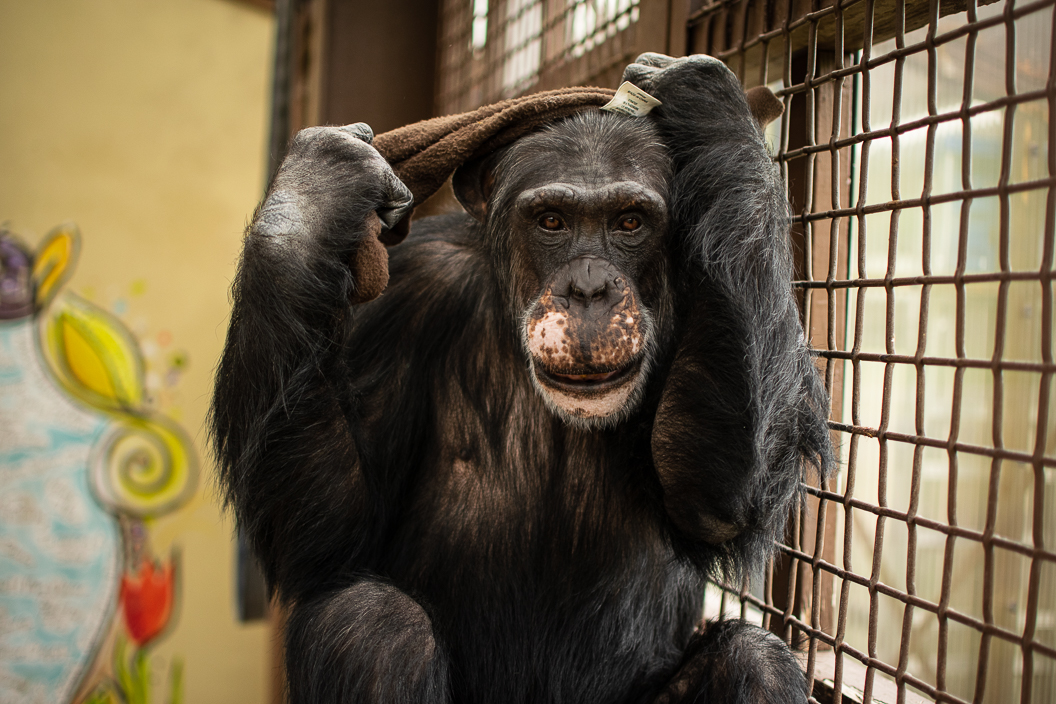Here at Chimpanzee Sanctuary Northwest, we take the physical health of our residents quite seriously.
Each day, the staff works as a team to make sure all of the essential tasks get done, and one necessary chore is the administration of medications to individual chimpanzees. Today, Chad was responsible for getting everyone their prescribed doses and recommended dietary supplements. Currently, we monitor conditions and treatments using paper forms that we then transcribe into a digital database. One of my ongoing projects is to coordinate our transition to a more modern system that allows us to record, discuss, warehouse, summarize and retrieve all of this information in a more centralized fashion. It’s a daunting endeavor, but I’m hopeful that it will enable us to be more efficient while continuing to provide the chimps with optimal health care.

Some of the chimps’ health concerns are chronic conditions that require long-term solutions. Burrito, for example, receives a daily cocktail of meds to manage his known heart condition. At other times, we may give chimpanzees short courses of anti-inflammatory or antibiotic drugs to help temporary wounds heal. It’s no secret that primates, even in the best conditions, occasionally have altercations that result in injury, so the number of individual chimps on meds waxes and wanes on a weekly basis. Right now, Jody and Foxie are being treated for unrelated, minor bite wounds located on each of their right feet. Jody’s injured foot is the same one that Dr. Erin investigated during her most recent trip to our on-site veterinary clinic. For the most part, though, the other chimps have been loyally serving as Jody’s primary “doctors” by keeping the site clean. Hygiene is almost always a group project for social primates such as chimpanzees, so it’s normal to see them tending to each other’s injuries as the lacerations and bruises slowly heal.


The cattle have also received some preventative health care lately. For those of you who may be unfamiliar with bovines, their feet are covered by cloven (two-toed) hooves. These structures are composed of keratin, just like claws and nails. The hooves of domestic cattle grow at a constant rate because their wild ancestors ranged across vast steppes and prairies; the constant travel across such rough substrate would gradually wear down their hooves if they didn’t offset the process with new growth.

Modern cattle, especially those inhabiting large-scale dairies and ranches, need their hooves trimmed regularly since they generally roam over shorter distances and softer terrain. The CSNW cattle have been exploring and grazing a variety of areas since they arrived, including the sanctuary’s expansive South Pasture, so they don’t need trims as frequently as other cows. Still, they need to have their feet checked and their hooves trimmed at least once a year (although we delayed this last trim due to the public health crisis). Overgrown hooves could lead to further problems, such as painful split nails, so we scheduled a professional hoof trimmer to take care of them this past week. He was excited to help out a sanctuary and was awed by Nutmeg’s massive frame. In the beef and dairy industries, steers like Nutmeg don’t live long enough to reach that size. He took a selfie with Nutmeg to show his friends and family, and the gigantic bovine seemed to make a new friend.


The trimming process is fascinating and, admittedly, a bit tense. The cattle have to be herded into a small corral and then led one-by-one down a chute into a tilt table. The tilt table firmly sandwiches them while they’re standing upright and then tips them on their side so that the trimmer can safely shave down the ends of their hooves. This step goes remarkably fast, though, and also gave Dr. Erin an opportunity to give the cattle their injectable annual vaccines. Within seconds, each cow is lowered back down and released. You’d think that they would be upset or afraid, but each of them seemed more interested in the trimmer’s truck and table apparatus. Nutmeg tried to sniff and lick everything, including the truck itself. Just minutes later, the cattle were already marching back to the pasture like nothing had happened.

Of course, health involves much more than medications and procedures. Over the past few decades, countless studies have supported that there are both tangible and intangible health benefits generated from having active lifestyles and enriching environments. Professionals in our field generally use the term enrichment to refer to puzzles, nesting materials, play structures, and other provisions that were once considered non-essential. More broadly, the term can be used to encompass anything and everything that contributes to the health and happiness of the chimpanzees. Burrito’s sanctuary experience, for example, is often enriched by rowdy play sessions in the Greenhouse. Foxie’s is enriched by a variety of dolls. Jamie’s is enriched by exposure to new footwear (and pictures of footwear arranged in a photo book, apparently).



That brings me to today’s video (embedded above). One of the caregivers on the Saturday shift (Diana? Kelsi? Anna? J.B.?) threw a roll of surplus raffle tickets into the enrichment baskets that were specially prepared for this morning. Maybe the idea was inspired by the ongoing virtual auction and upcoming Queen’s Brunch celebration. (Note: You can see the items up for auction > here <. Have you seen the print of Willy B that’s receiving bids? What a cool-looking dude…)

Whatever the case, the raffle tickets were a hit with Honey B, Mave and Willy B, and we all took a break from our chores to watch them roll around in the piles of torn paper. Staying healthy, after all, can’t be done purely through paperwork and pills. Sometimes it’s having fun (and watching chimpanzees have fun) that makes the biggest difference. Burrito knows this well.







